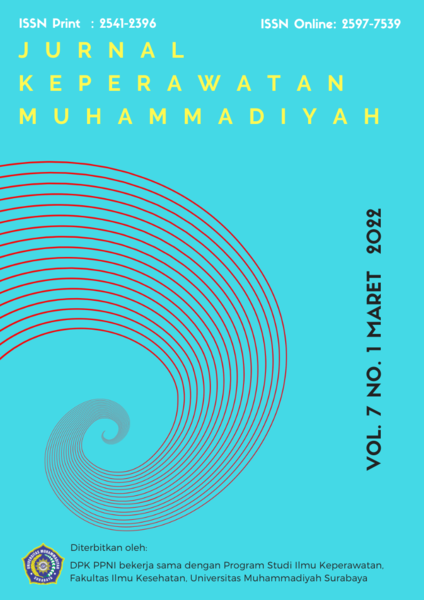Korelasi Antara Aktivitas Sehari-hari Ibu Rumah Tangga dengan Kejadian Carpal Tunnel Syndrome di RS Toeloengredjo Pare Kediri
DOI:
https://doi.org/10.30651/jkm.v7i1.10933Keywords:
carpal tunnel syndrome, housewife activities, gerakan repetitive motionAbstract
Â
Â
Â
Â
Â
Â
Â
Â
Â
Objective: Carpal tunnel syndrome (CTS) is a syndrome caused by compression of the median nerve in the carpal tunnel in the wrist. Symptoms include pain, numbness, and paresthesia. CTS is common in women, 9.2% in women, 8% in men with the highest outcome being housewife.
Methods: This study uses a quantitative cross-sectional design, the approach is observational. The sampling technique was purposive sampling, the number of studies was 30 housewife patients with carpal tunnel syndrome at the Physiotherapy Polyclinic, Toeloengredjo Hospital, Pare, Kediri. This study was conducted by giving informed consent and questionnaires to housewife with CTS. Statistical test using the chi-squere test.Results: The results of the chi-square test were obtained from 30 respondents with an average age of 51.70 years, the results of repetitive motion with the phalen test were 0.030% (p<0.05%), the results of repetitive motion with CTS pain were 0.00% (p<0, 05), repetitive motion with CTS criteria 0.000% (p<0.05). This shows that there is a correlation between the activities of housewife and the incidence of CTS.
Conclusion: There is a correlation between age, hand pain, and repetitive movement with the incidence of Carpal Tunnel Syndrome in the daily activities of housewife. The correlation between age and the incidence of CTS, the older the age, the more at risk of CTS. The correlation between repetitive motion and CTS criteria is the heaviest value due to manual washing of clothes every day, the heavier the load, the greater the risk of CTS.  ÂReferences
Bahrudin, M. (2011). Carpal Tunnel Syndrome. Saintika medika (Jurnal Bidang kedokteran dan kesehatan).7(14), 78-87.
Chammas, M. B. (2014, September - Oktober). Carpal Tunnel Syndrome - Part T 1 ( anatomy, physiology, etiology and diagnosis). Retrieved 2021 2014, from Revista Brasileira de Ortopedia,: htpps://doi.org/10.1016/j.rboe.2014.08.001
Genova, A. D. (2020). Carpal Tunnel Syndrome. A Review of Literature.
Genova, A., Dix, O., Saefan, A., & Thakur,M. (2020). Carpal Tunnel Syndrome: A Review of Literature. pp. Cureus 12 (3):2-3.
Ibrahim, I. K. (2012). Carpal Tunnel Syndrome : A Review of the Recent literature. The Open Otrhopedics Journal, pp. 69-76.
Ilyas MF. (2015). Hubungan usia dan masa kerja dengan posisi pergelangan tangan terhadap Carpal Tunnel Syndrome pada sopir bajaj di Jakarta barat. Gamabran faktor-faktor yang terkait dengan kejadian Carpal Tunnel Syndrome pada Ibu Rumang Tangga di Desa Guji Baru.
Lazuardi Al. (2016). Determinan gejala Carpal Tunnel Syndrome pada pekerja pemecah batu di Kecamatan Sumbersari dan Sukowono Kabupaten Jember. In Fakultas kesehatan masyarakat Universitas Jember (pp. 4-5). Jember.
MF, I. (2015). Hubungan usia dan masa kerja dengan posisi pergelangan tangan terhadapbcarpal tunnel syndrome pada supir bajaj di jakarta barat. Skripsi Jakarta : Universitas Muhammadiyah Jakarta.
Nissa, P. C. et al. (2015). Hubungan Gerakan Repetitif Dan lama Kerja dengan Keluhan Carpal Tunnel Syndrome Pada Mahasiswa Tehnik Arsitektur. Jurnal Kesehatan Masyarakat (e-Jurnal),3(3), pp. 563-571.
Noor, Z. (2016). Buku Ajar Gangguan Muskuloskletal. Jakarta selatan: Salemba Medika.
Padua, L. C. (2016). Carpal Tunnel Syndrome. Retrieved 2021, from The lancet Neurology, 15(1): https://doi.org/10.1016./S1474-4422(16)30231-9
Palmer, L. T. (2011). Carpal Tunnel Syndrome: The role of occupational factors. Europe PMC Funders Group. Retrieved 2011, from http://doi.org/10.1016/j.berh.2011.01.014.Carpal
Sekarsari, D. P. (2017). Hubungan lama kerja, gerakan repetitif dan postur janggal pada tanagn dengan keluhan carpal tunnel syndrome (cts) pada pekeja pemecah batu di kecamatan moramo utara kebupaten konawe selatan tahun 2016. JIMKESMAS, 1-9.
Sevy,J.,& Varacall, M. (2020). stapearls 1-2. Retrieved from Carpal Tunnel Syndrome.
Downloads
Published
Issue
Section
License
- Penulis tetap memegang hak atas karyanya dan memberikan hak publikasi pertama kepada jurnal ini yang secara simultan karya tersebut dilisensikan di bawah:Â Creative Commons Attribution-ShareAlike 4.0 International (CC BY-SA 4.0)













